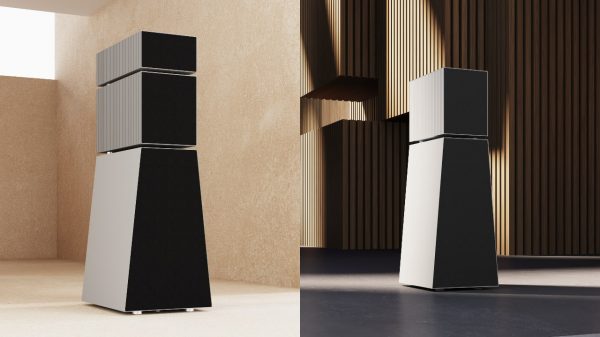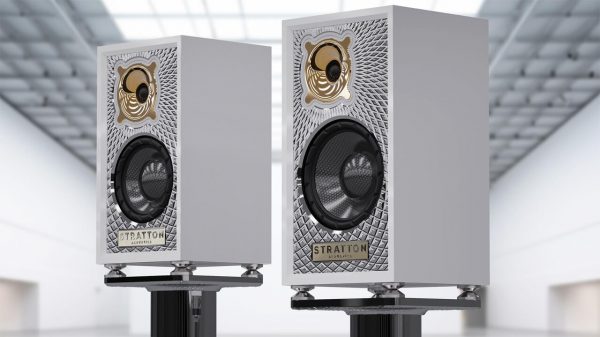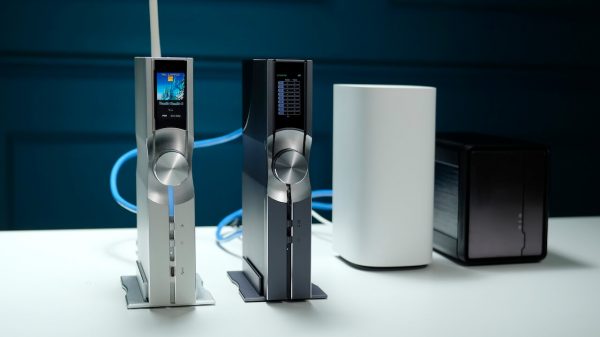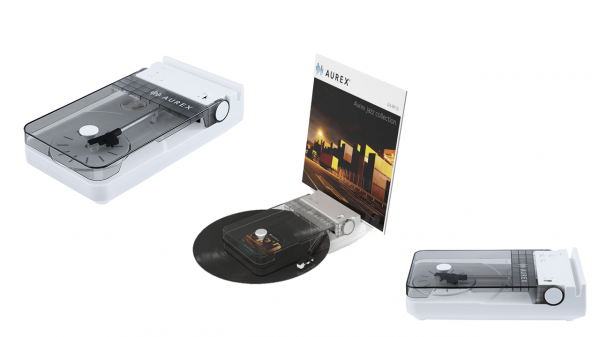All-New Flagship Line-Up Rewrites Standards of Performance
For some 35 years PSB Speakers has enjoyed an enviable global reputation for designing and producing loudspeakers that deliver the highest performance available at a wide range of price-points — whether the criteria are subjective evaluation through critical listening, or laboratory results via rigorous measurement. PSB is equally well known for its fundamental research into the behaviors of loudspeakers, listeners, and listening rooms, and the interactions among them, conducted cooperatively with the Canadian National Research Council at the NRC’s world-standard acoustical laboratories in Ottawa, Ontario.
The Synchrony Collection
Now, in its most significant introduction in a decade, the Canadian firm has revealed its latest family of “statement” designs: PSB Synchrony. The Synchrony range combines rare musicality and technical excellence, with startlingly compact, small-footprint design, and sculptural finish of unequalled -quality that looks and integrates stunningly into today’s listening rooms.
Synchrony reflects PSB’s longstanding philosophy: that great music recordings offer the fullest and most meaningful test of any loudspeaker. Consequently, the Synchrony designs are exhaustively engineered, balanced, and voiced to produce extraordinarily consistent, rigorously accurate, and astonishingly transparent and dynamic musical reproduction across the line. Synchrony comprises seven new models: two full-range tower designs, two more compact, stand-mount “bookshelf” models, and two center-channel speakers, plus a “tri-mode” surround-channels layout engineered for the side and rear locations of multichannel groupings. These seven cover a wide range of applications and system-budgets, but share all their important design essentials in common.
The first and foremost of these is an intensive, tireless, three-year development process. “People naturally look for ‘revolutionary’ new loudspeakers,” says company founder and design-team leader Paul Barton. “It’s human nature. But this is a very mature technology: a lot of really excellent minds have been working on the problem for some 75 years now.” Barton continues, “Cones and domes, boxes and crossovers may seem ‘boring’ to marketing departments, but they remain the very best tools for sound reproduction. Refinement, refinement, and still more refinement is the PSB way of achieving ‘breakthrough’ performance, and in the Synchrony line we’ve taken this to a degree that’s simply without precedent.”
The Synchrony Story in Brief
The Synchrony drivers, enclosures, and crossover circuits are all ground-up components, but in every case are important evolutions of longstanding PSB technologies. The Synchrony structures reflect continued development of PSB’s unique, proprietary cabinet-construction system, employing extruded-aluminum corners and tapered rear panels, in combination with elegantly veneered, 7-laminate wood-composite curved side panels, to form what is possibly the strongest, “deadest,” most non-resonant and coloration-free enclosures in the industry.
Synchrony continues PSB’s tradition of extended-response titanium-dome tweeters, in a new generation that extracts even greater high-output linearity thanks to multiple technical enhancements in its neodymium magnet structure, lighter, stiffer voice-coil components, and enhanced mechanical systems. Equivalent developments in the 6.5-inch and 5.25-inch cone woofers employed throughout the line and the Synchrony One’s 4-inch midrange as well, have concentrated on improving linearity and virtually eliminating dynamic compression. In addition to their distortion-arresting electro-magnetic elements (aluminum bullet, copper “shorted-turn,” and aluminum magnetic focusing ring), the Synchrony cone drivers all employ a newly developed sandwich-laminate diaphragm material composited from woven fiberglass and compressed felted-complex natural materials, as well as ultra-rigid, cast-aluminum baskets. The sum of these parts is fast-reacting, pure reproduction that contributes impressively lifelike transients and unprecedentedly clean, high-output bass.
PSB’s care in crossover design and driver-circuit electro-acoustic integration, already widely admired, has been even further developed for the Synchrony line. All models employ fourth-order acoustic Linkwitz-Reilly sections, for the best possible unification of drivers into a single acoustic entity, with minimal errors in both the amplitude (frequency-response) and time (phase-response) domains, and insignificant static and dynamic distortions. Consequently, the Synchronys’ ability to conjure up depth, imaging precision, and spatiality from both two-channel and multichannel productions, is nothing short of uncanny.
Superb performers on their own merits, PSB’s latest flagship designs are equally unique in the degree to which work to answer the real-world problems of integrating the loudspeaker with the reproduction system and the listening room. All of the Synchrony models are engineered to produce stable, overwhelmingly resistive (and thus easy-to-drive) loads over their full high-power operating ranges: in short, they make amplifiers work better and sound better.
Each Synchrony is designed so that its “in-phase lobe” is balanced and even throughout the seated-to-standing vertical window of the prime listening area (hence their “tweeter-under” layouts), ensuring their superb sound under real-life listening conditions. The towers are extensively engineered so that their primary “floor-bounce” reflections, the Achilles-heel of any floorstanding speaker, actually help smooth and extend mid-bass and midrange response, rather than peak-and-dip roughening it as does virtually every other floor design. They are further supplied with simple but potentially very valuable port-tuning plugs, enabling owner or system-designer/installer to effect small, subtle, but very meaningful corrections in room-specific low-frequency smoothness on site. And the entire Synchrony line is extraordinarily superbly matched in timbre — a claim often made but rarely supported — so that any selection of floor, stand, and multichannel models may combine to form a tonally cohesive surround system.
Floorstanding: Synchrony One and Synchrony Two

The two tower-model Synchrony PSBs are full-range reproducers capable of delivering the most technically refined and demanding recordings available with unexcelled realism and tonal, spatial, and dynamic accuracy. The Synchrony One is a five-driver “five-way transitional” array, in which three identical 6.5-inch woofers sum their outputs across the lowest octaves but roll off, each at a different frequency throughout the midrange, which inherently smooths response both on-axis and off. Each driver operates in a slightly different, fully isolated enclosure volume, each of which is vented by way of slightly different port dimensions and calculations.
The resulting construct is incredibly complex in both amplitude and time domains — the Synchrony One and Two designs would be utterly impossible to undertake without advanced computer modeling and simulations–but delivers remarkable extension and accuracy from the very lowest octaves, and response that remains, almost incredibly, within a 1-dB window from 70 Hz to 10 kHz (Synchrony One). Equally important, thanks in large part to the new Synchrony woofers’ unique performance, the models One and Two share extraordinary freedom from low-frequency non-linearities: well below a half percent. According to Paul Barton, these are among the first wide-dynamic-range speakers in history from which inherent distortion is not a meaningful audible factor.
The Synchrony Two is similar in its overall design, employing smaller, 5.25-inch woofers in all three position and thus obviating the need for a discrete midrange driver. Its narrower, smaller footprint is ideal for more intimate settings, yet its performance very nearly matches the S1, giving up less than a half-octave of deep-bass extension and very modest degrees of ultimate dynamic range.
Bookshelf/Stand-Mount: Synchrony One B and Synchrony Two B
Synchrony’s two “bookshelf” models were conceived both for main-channel use in smaller rooms or systems, and for multichannel deployments. The One B, a 6.5-inch two-way, and the Synchrony Two B, a 5.25-inch model, are essentially identical in other respects, both employing the Synchrony high-linearity titanium-dome tweeter and dual-laminate-weave woofers, and the same construction and crossover details. Each is excellently suited for use with a high-performance subwoofer such as PSB’s own ultra-compact HD models, yet either one is fully capable of serious music reproduction on its own: the One B delivers useful output to a remarkable 40 Hz. Though more compact (and more affordable) than the tower Synchrony models, the “B’s” are astonishingly close in sound (within their operating ranges), both to each other and to their larger floorstanding siblings.
Multichannel: Synchrony One C, Two C, and Synchrony S
PSB created the Synchrony family to be definitive music reproducers, both in stereo and in multichannel playback, which makes them dazzling home-theater performers as well. Consequently, the family includes center and surround-channel models engineered from the ground up to maximize its performance in multichannel systems. There are two center-channel models. The Synchrony One C is a large three-way design using the same drivers as the Synchrony One in a dual-woofer, horizontal layout, and delivering virtually identical timbral and dynamic response with impressive bass extension (40 Hz) that encourages the “large” center-channel setting many designers prefer in serious-listening multichannel systems. The Synchrony Two C is a more compact two-way design employing dual 5.25-inch woofers, voiced to achieve virtually perfect tonal matching.
Intended for side/rear-channels deployment in multichannel installations, the Synchrony S is a dedicated “tri-mode” speaker comprising dual two-way arrays employing the drivers of the Synchrony One B. This tri-mode design may be operated as a dipole-surround, as preferred by many home-theater designers for movie-centered systems, as a monopole reproducer for multichannel music playback where the most rigorous matching of timbre and directionality is demanded, or in bipolar mode (all four drivers operating and in-phase) for maximum coverage, dispersion, and output.
PSB’s Synchrony family of loudspeakers are available in the choice of select, hand-rubbed dark cherry and black ash veneers. They will be available immediately, at the following manufacturer’s suggested prices:
| Model | Price |
| Synchrony One (5-driver tower) | $4,500/pair |
| Synchrony Two (4-driver tower) | $3,000/pair |
| Synchrony One B (6.5-inch “bookshelf”) | $2,000/pair |
| Synchrony Two B (5.25-inch “bookshelf”) | $1,500/pair |
| Synchrony One C (3-way center-channel) | $2,000 each |
| Synchrony Two C (2-way center-channel) | $1,300 each |
| Synchrony S (Tri-mode surround-channel) | $2,000/pair |
A Synchrony Model B monitor-stand will be available later in the year, at a price to be determined.
































